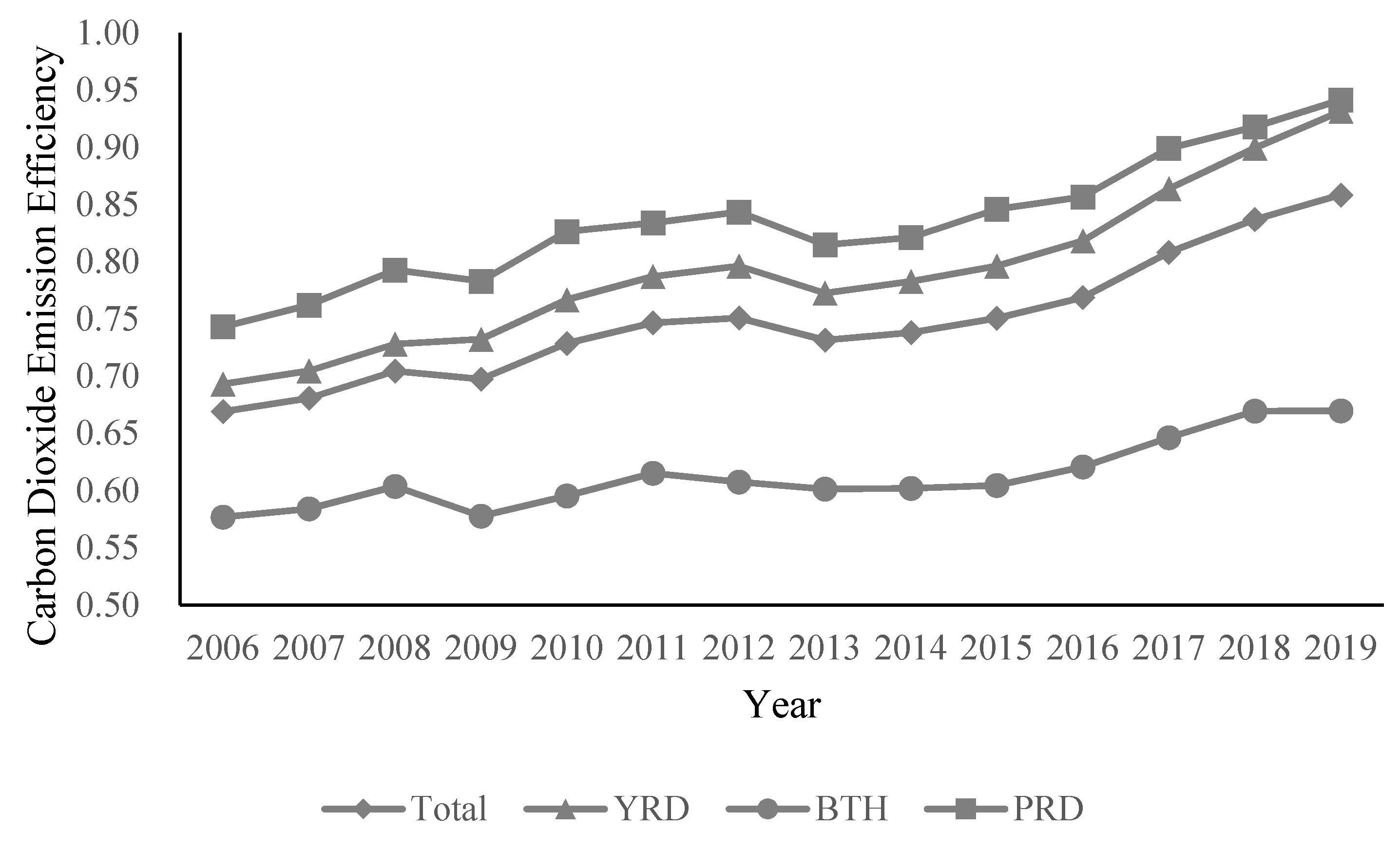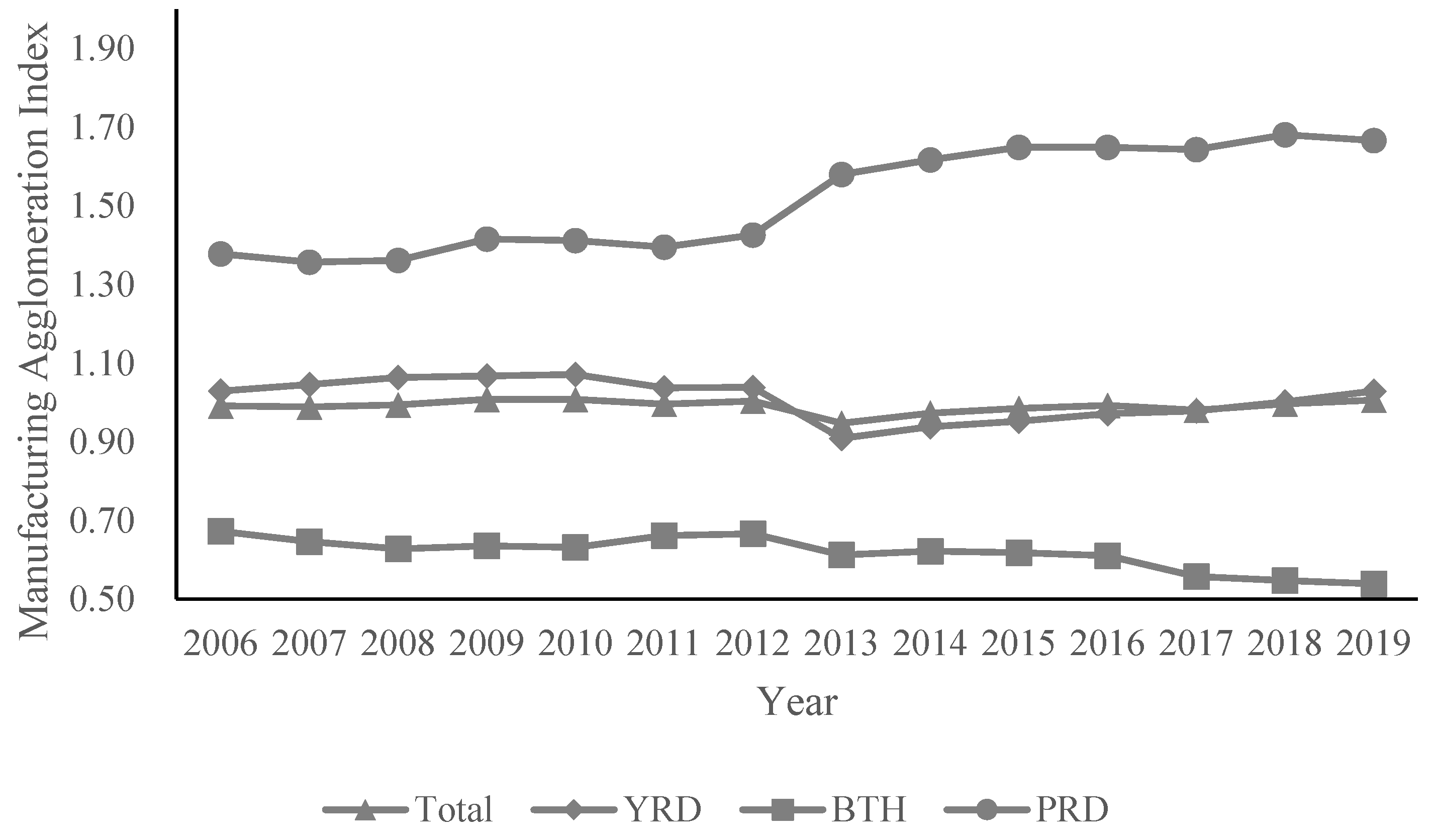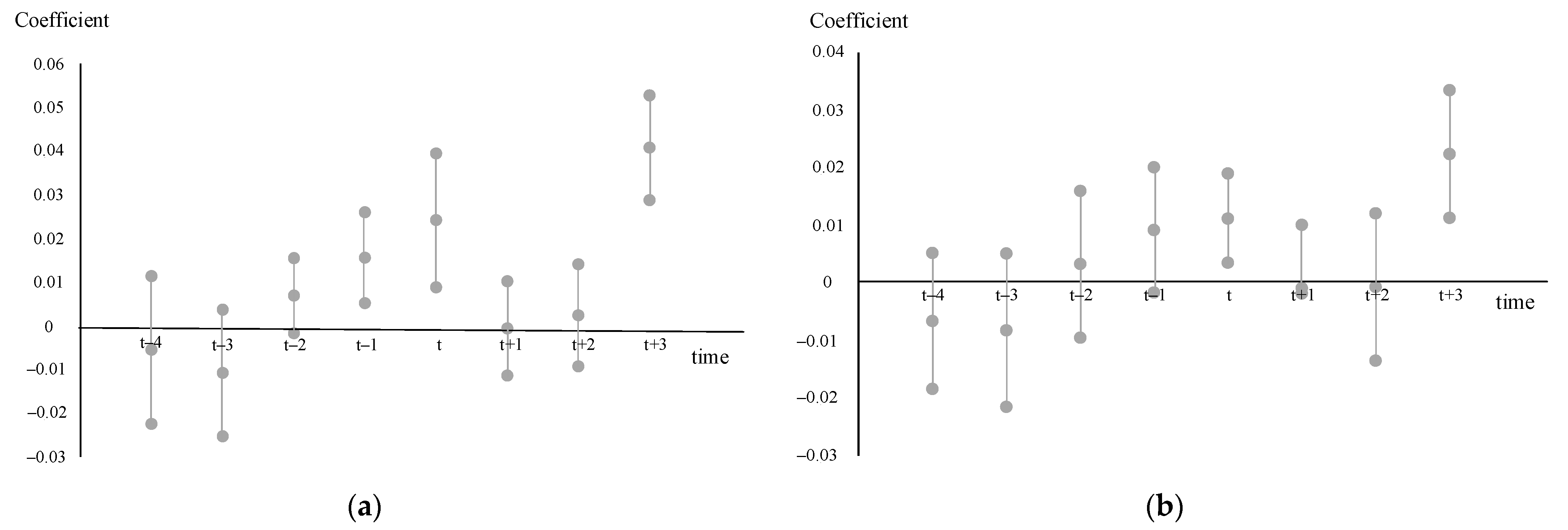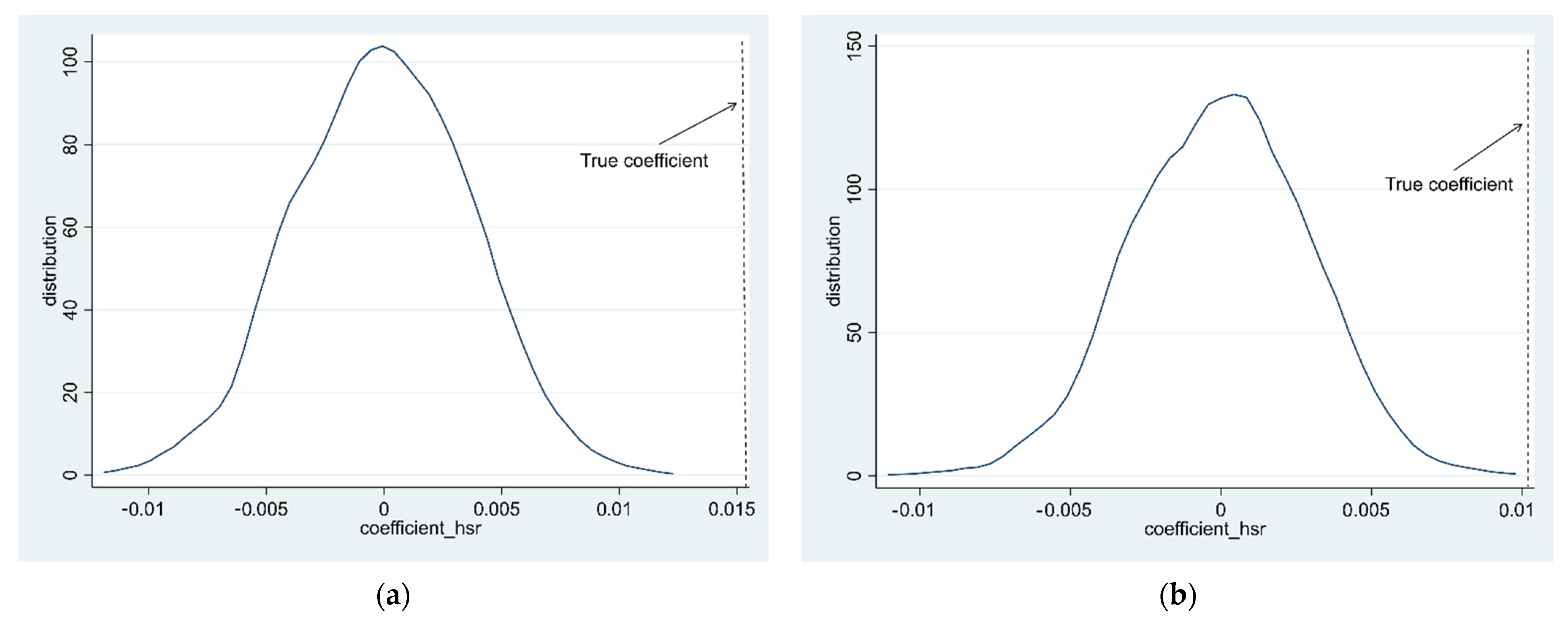1. Introduction
Under the background of global climate and environmental change, the scarcity of environment and natural resources has increased, and economic activity restrictions have been continuously enhanced. Environmental problems have become the main challenge restricting sustainable development, especially in developing countries [
1]. As the largest developing country, China plays a vital role in promoting the sustainable development of the global environment [
2]. In September 2020, in the 75th U.N. General Assembly, President Xi Jinping made a solemn commitment to the world that China’s carbon dioxide emissions will peak by 2030 and be carbon neutral by 2060. In 2010, the transportation sector produced about 23% of energy-related carbon dioxide emissions. If we do not take any positive mitigation measures, the carbon dioxide emissions related to transportation may double by 2050 and even triple by 2100 [
3]. Therefore, the transportation sector has great potential to achieve the goal of carbon neutrality and carbon peaking [
4]. At present, high-speed rail construction is considered a fundamental approach to promoting the environment’s sustainable development [
5]. On the one hand, high-speed rail generates less carbon dioxide emissions than civil aviation, automobile, and other transportation modes [
6,
7]. On the other hand, large-scale high-speed rail construction will significantly reduce transportation costs and promote the flow of talent, capital, and technology, thus promoting regional technological innovation and reducing the environmental pollution of enterprise production [
8,
9].
At present, China’s economic development focuses on developing the construction of urban agglomerations with big cities as the core. Transportation development is an essential means of promoting cluster growth, and strengthening the organic combination of transportation and urban agglomeration construction is particularly important for backward areas. Beijing–Tianjin–Hebei, Yangtze River Delta, and Pearl River Delta are the most critical locations for China to implement the strategic layout of urbanization. Promoting the deep integration of these three major urban agglomerations and giving full play to their primary functions and potential are the key points of China’s regional optimization and coordinated development.
During the 13th Five-Year Plan period, the rail transit development of the three major urban agglomerations achieved many successes. The operating mileage of the Beijing–Tianjin–Hebei high-speed railway increased 41.6% from 1616.3 km to 2288.6 km. The high-speed rail mileage in the Yangtze River Delta increased 84.9% from 3250 km to 6008 km. Meanwhile, the high-speed rail mileage in Guangdong–Hong Kong–Macao Greater Bay Area was 1232 km at the end of 2019. Its high-speed rail network density was the highest among the three major urban agglomerations. Overall, the current high-speed rail mileage in Beijing–Tianjin–Hebei, Yangtze River Delta, and Guangdong-Hong Kong-Macao Greater Bay Area has exceeded 9500 km, accounting for a quarter of the national total. In addition, in the outline of the 14th Five-Year Plan, the goal of these three urban agglomerations is mentioned: “Build Beijing–Tianjin–Hebei in orbit; accelerate the construction of inter-city railway in Guangdong–Hong Kong–Macao Greater Bay Area; achieve complete coverage of high-speed rail in cities above the prefecture-level in the Yangtze River Delta”. The high-speed rail construction has dramatically shortened the distance between central marginal towns and cities in the three major urban agglomerations. It will promote the spatial correlation of urban agglomerations. So, in recent years, has the rapid development of high-speed rail construction in China’s three major urban agglomerations promoted carbon dioxide emission efficiency? If not, what is the limiting factor, and how can the environmental effect of high-speed rail be exerted in the future?
Recently, academic circles have widely focused on the relationship between high-speed rail construction and environmental pollution. Moreover, many scholars have conducted empirical research on high-speed rail construction and have found that it significantly improved the environmental quality.
Firstly, some researchers found that high-speed rail is cleaner than other modes of transportation. The continuous development of high-speed rail construction replaces much highway and civil aviation passenger traffic, thus reducing carbon dioxide emissions [
10,
11,
12]. Secondly, high-speed rail construction has dramatically reduced transportation costs, bringing industrial agglomeration [
8]. It will benefit the upgrading of regional industrial structures and further reduce the emission of environmental pollutants [
9,
13,
14].
Thirdly, the construction of high-speed rail is also conducive to the flow of labor, capital, technology, and other factors. On the one hand, with the weakening of the barriers to factor flow, factor allocation efficiency has been dramatically improved, thus reducing the emission intensity of industrial pollution [
9,
15]. On the other hand, reducing transportation costs is conducive to the technical connection between regions and promotes regional technological innovation. Improving production efficiency and cleaner production technology will be conducive to energy saving and emission reduction [
16,
17]. In addition, the construction of high-speed rail has also strengthened the interregional ties, which will impact the local environment and have a spatial spillover effect on the surrounding areas [
18]. Fang [
14] found that high-speed rail construction can reduce smog pollution by upgrading industrial structures and developing the real estate market. At the same time, urban smog pollution has a strong spatial correlation. Li [
19] also found that the environmental pollution of enterprises in a region will be transferred to the surrounding areas through the high-speed rail network. Further, the spillover effect of pollution space is significantly related to the economic development, environmental investment, the number of enterprises, and other factors in the region.
However, some scholars believe that the construction of high-speed rail will have a negative impact on the environment. On the one hand, as the opening of high-speed rail greatly facilitates residents’ travel, it will lead to more traffic demand to a certain extent, which will lead to an increase in carbon dioxide emissions [
20,
21,
22,
23]. Givoni and Dobruszkes [
20] found that the opening of a high-speed railway leads to a 20% travel demand increase. On the other hand, the construction of high-speed rail will generate a large number of pollutants [
2,
24]. Yue [
25] comprehensively considered the environmental effects during the construction of the Beijing–Shanghai railway line and pointed out that the process included greenhouse gas emissions and PM2.5 emissions, fossil resource consumption, surface water eutrophication, and other issues. Kaewunruen [
26] found that 64.86% of carbon dioxide emissions and 54.31% of energy consumption in the whole life cycle of high-speed rail construction come from the construction stage.
The literature has discussed the relationship between high-speed rail construction and environmental pollution and the possible intermediate mechanism from different perspectives. However, the existing research still has the following problems: (1) Many pieces of literature have discussed the impact of high-speed rail construction on carbon dioxide emissions and PM2.5, but little research pays attention to its effects on environmental efficiency compared with the total amount of pollutants. The carbon dioxide emission efficiency can better reflect whether a region has green and low-carbon development potential and can achieve sustainable development [
27]. (2) Most literature builds a difference-in-difference model to compare the difference in carbon dioxide emissions before and after opening a high-speed rail. However few pieces of literature consider the spatial correlation brought by high-speed rail construction. However, if the spatial factor is not considered, the estimation result will be biased. (3) At present, most literature is based on the data of all cities in China. However, different regions in China have different development characteristics and resource endowments, and the impact of high-speed rail construction on the environment of different areas should be different. Therefore, this paper intends to use the data of three major urban agglomerations in China to build the SBM-DEA and spatial DID models to explore the relationship and internal mechanism between high-speed rail construction and environmentally sustainable development.
The research contribution of this paper is mainly manifested in the following three aspects. Firstly, we built the SBM-DEA model to measure each city’s carbon dioxide emission efficiency in the three urban agglomerations in order to measure the environmental sustainability of urban agglomerations more accurately. Secondly, we constructed a spatial DID model to estimate the impact of high-speed rail construction on carbon dioxide emission efficiency more accurately by adding spatial factors into the model. Thirdly, we provided corresponding policy suggestions for regions with different development characteristics by comparing the impacts of high-speed rail construction on the environmental efficiency of three major urban agglomerations.
The remainder of this study is structured as follows.
Section 2 explores the relationship between high-speed rail construction and sustainable development of urban agglomeration environments through theoretical mechanism analysis.
Section 3 describes the SBM-DEA model used to calculate three major urban agglomerations’ carbon dioxide emission efficiency. In
Section 4, we introduce the model construction process and the index selection.
Section 5 mainly presents regression results, robustness analysis, mechanism test, etc. The last section is the conclusion and policy implications.
6. Conclusions and Policy Implications
This paper calculated each city’s carbon dioxide emission efficiency by SBM-DEA model based on the panel data of three major urban agglomerations in China from 2006 to 2019. Then, we constructed DID and spatial DID models to explore the impact of high-speed rail construction on the sustainable urban environment of the three major urban agglomerations. The research found that:
On the whole, the construction of high-speed rail has significantly improved the carbon dioxide emission efficiency in local and surrounding urban areas, which is conducive to the sustainable development of the local environment. In addition, from the impact of high-speed rail construction on the carbon dioxide emission efficiency of central cities and peripheral cities, we can see that the opening of high-speed rail has no significant effect on the carbon emission efficiency of central cities. However, it has significantly promoted all regions’ positive spatial spillover effect. In other words, it has enabled the green and low-carbon development of neighboring areas.
Regarding regions, the impact of high-speed rail construction on three major urban agglomerations’ carbon dioxide emission efficiency is different.
First of all, the construction of high-speed rail has significantly promoted the efficiency of carbon dioxide emission in the Beijing–Tianjin–Hebei region. However, it has had a negative spatial spillover effect on neighboring areas. The possible reason is that high-speed rail construction promotes the loss of many resources around Beijing, Tianjin, and Hebei. As a result, the resource allocation efficiency is not high, which further inhibits carbon dioxide emission efficiency from improving.
Secondly, the construction of high-speed rail has significantly promoted the spatial agglomeration of the manufacturing industry in the Pearl River Delta region. However, industrial agglomeration has brought about the reduction of local carbon dioxide emission efficiency. The possible reason is that high-speed rail construction stimulated the agglomeration of the highly polluting manufacturers, thereby inhibiting regional carbon dioxide emission efficiency.
Thirdly, considering the spatial factors, the impact of high-speed rail construction on the carbon emission efficiency in the Yangtze River Delta region is not apparent. The possible reason may be the high level of technology in the Yangtze River Delta region itself. The impact of high-speed rail construction on the innovation level of its manufacturing industry is not significant. Thus the effect on the local carbon emission efficiency is not significant.
From the event analysis results, the impact of high-speed rail construction on urban agglomerations’ urban carbon dioxide emission efficiency has a lagging effect. From the regression results, the high-speed rail construction has the most significant impact on environmental efficiency when it lags for three periods. The reason is that the construction of high-speed rail first promotes the free flow of factors, but its influence on factor allocation efficiency will take some time.
The above conclusions have the following policy implications for the sustainable development of China’s urban agglomeration environment:
Firstly, the Chinese government should continue to improve the construction of high-speed rail networks in urban agglomerations to promote the sustainable development of the environment. In the future, the Chinese government needs to continuously strengthen the construction of high-speed rail to realize the following development goals: 1–3 h traffic circle between neighboring large and medium-sized cities and 0.5–2 h traffic circle within urban agglomerations. The high-speed rail will exert the space–time compression effect, promoting the efficiency of factor space allocation and enhancing the city’s innovation ability, leading to the improvement of the carbon dioxide emission efficiency.
Secondly, each urban agglomeration should take heterogeneous measures to realize environmental sustainability according to its characteristics. For the Beijing–Tianjin–Hebei region, the local government should strengthen the links between central and peripheral cities and enhance their cooperation to promote technological innovation in the peripheral areas, improving carbon dioxide emission efficiency. For the Pearl River Delta region, the local government needs to adopt strategies to encourage local high-pollution manufacturing industries to innovate for saving energy and reducing emissions. For instance, they could give them more energy-saving and emission-reduction subsidies to achieve green and low-carbon development. For the Yangtze River Delta region, we will continue to upgrade the local industrial structure and promote the agglomeration of manufacturing industries to realize the high-quality development of the area.
Finally, the construction of high-speed rail needs a long-term evaluation from the whole life cycle perspective to maximize cost savings and improve the social effects of transportation infrastructure. The lagging impact of high-speed rail construction on the environment exists, so the government needs to evaluate the short-term and long-term environmental costs and benefits of high-speed rail construction in advance. Then, we could determine the quantity and quality of high-speed rail construction in this area to maximize overall social welfare.












